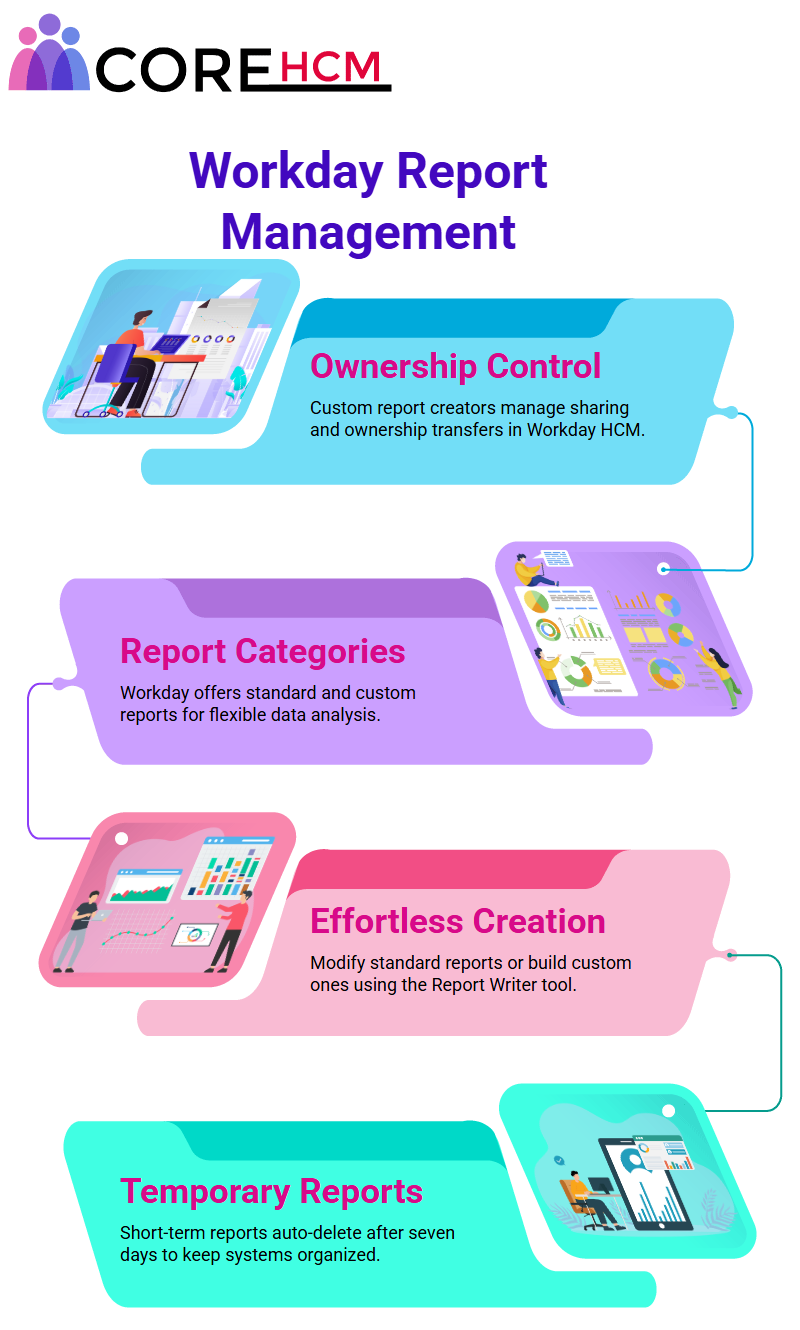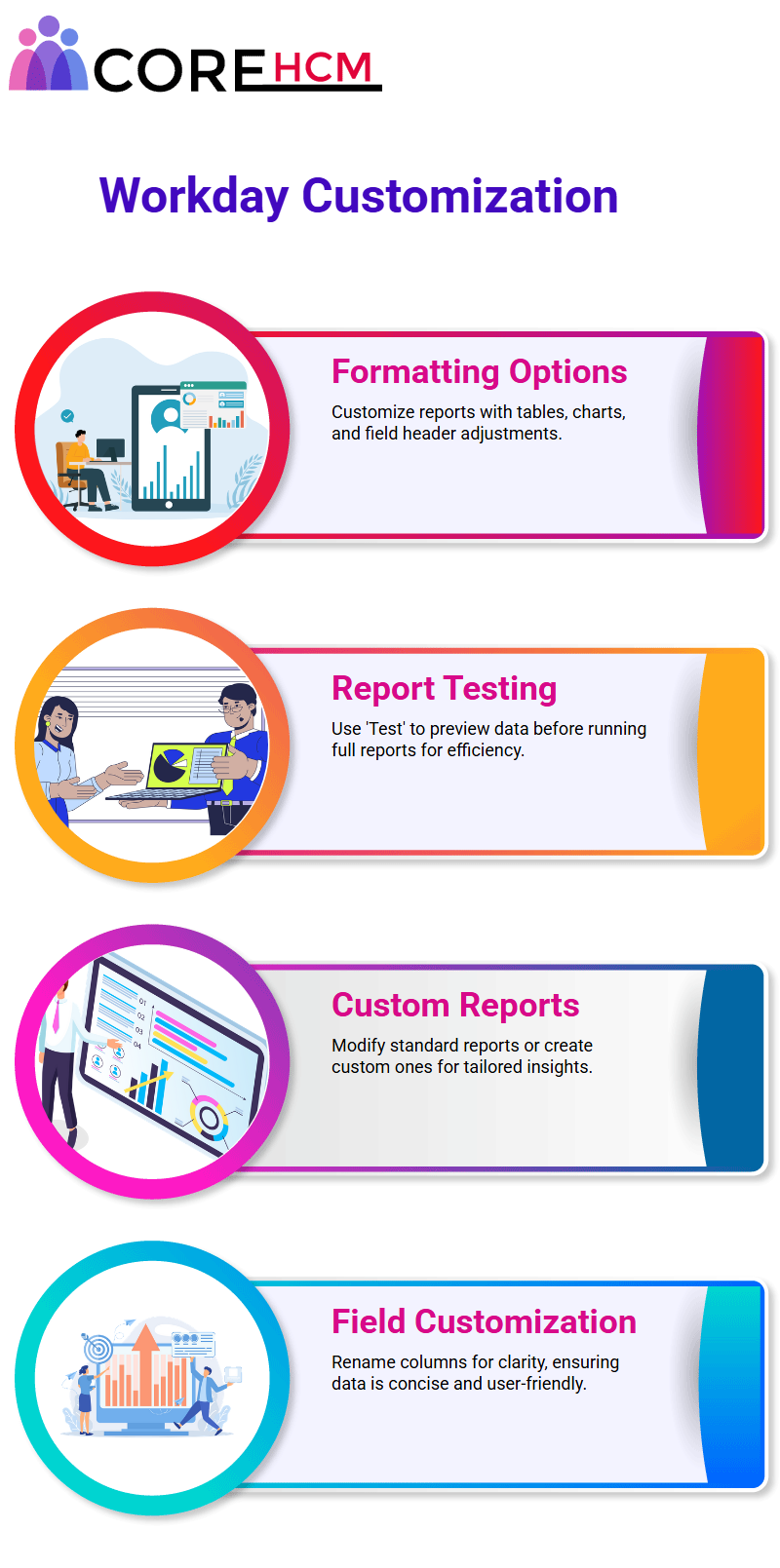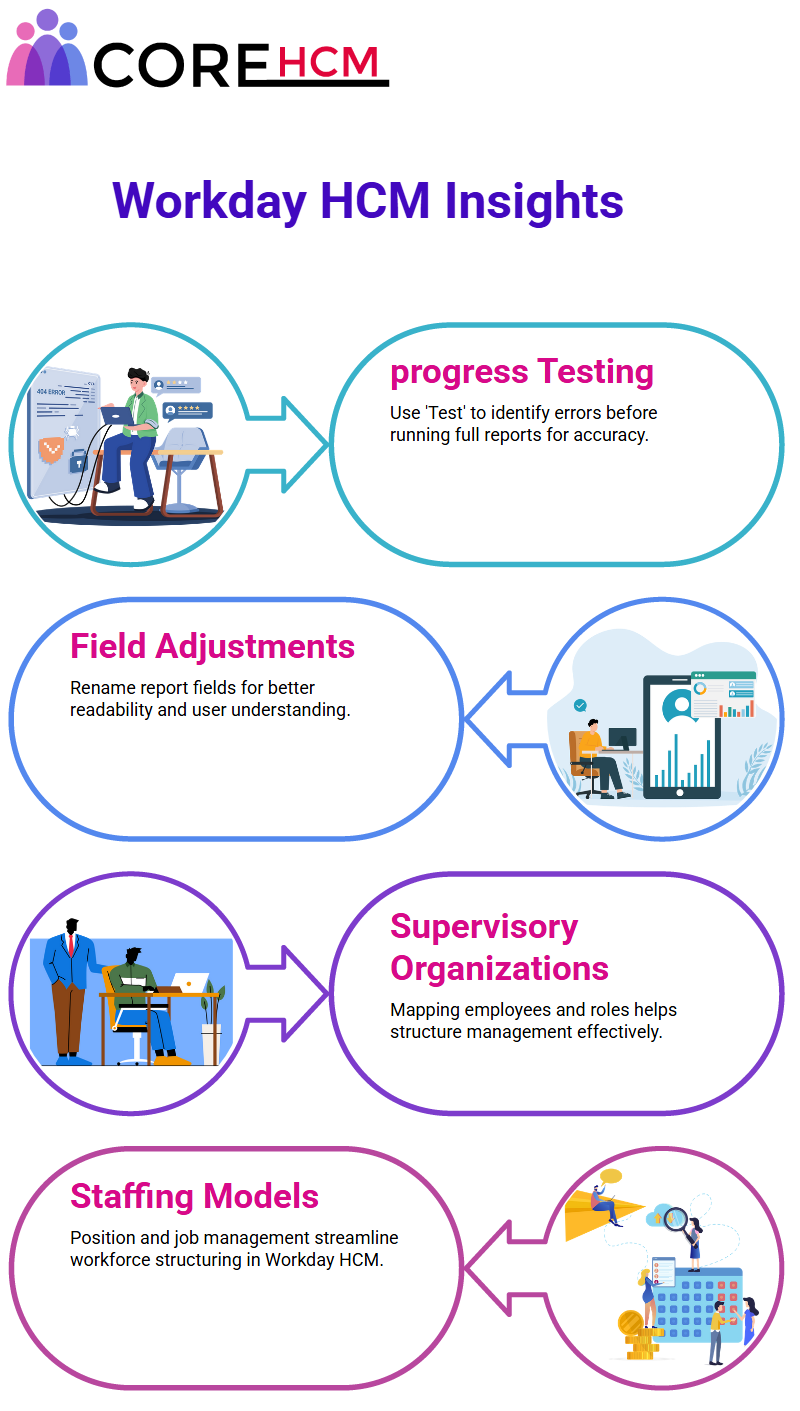Master Workday Training in Hyderabad’s Leading Experts
Workday HCM Course in Hyderabad
Explore Workday HCM Reports
Let’s walk through some standard reports available within Workday HCM that can prove extremely helpful.
The Base P Report goes beyond simply displaying rows and columns of data; it goes one step further by including an innovative chart similar to pivot charts found in Excel.
What makes the Base P Report particularly striking is how each value included acts as a link employees’ names, positions or manager details all serve to strengthen its links within its page.
It makes taking actions directly against workers easy by giving users direct access to report output on its interface, without needing to export to Excel first; eliminating an extra step is part of its goal.
Workday HCM Report Enhancements to Benefit Employers (WLBEs). Similarly, its charts can also be ordered in decreasing order by salary to make trends easier to spot and recognize.
Also features sorting features within reports to add further flexibility when creating reports for management decisions.
Adding Value to Workday HCM Reports
Workday HCM already boasts comprehensive reports that provide ample insights, yet there’s always room for enhancement.
Take, for example, the Base P Report it would be even more helpful to include information like hire dates or employee locations to tailor it more precisely to specific requirements.
Workday HCM Course in Hyderabad programs often use such enhancements to show how reports can be adapted in real-world scenarios.
Headcount Trend reports are another essential source for managing headcount data over five years.
Searching for this report sometimes requires multiple attempts in certain tenants; once found however, its data visualization capabilities make for striking reading.
It allows users to effortlessly navigate report definition and gain more personalized insights by exploring its smooth user-interface.
Discovering More in Workday HCM
Another report worth investigating in Workday HCM is the Fine Workers report, designed to assist employees in quickly finding employees based on various criteria.
It’s straightforward and effective – an indicator of its dynamic capabilities.

Understanding Workday HCM Filters
First let’s consider how Workday HCM uses filters to make life simpler for users. Imagine looking at a screen where employees are listed along the right and filter criteria are listed along the left side.
Not unlike shopping online? Choose filters such as age group or department and instantly, Workday HCM narrows its results down to only include employees between 21-30.
Workday HCM Course in Hyderabad often trains professionals on using such filters for optimizing talent management strategies.
It makes searching and finding employees easy! And its comparison feature can make the comparison between two workers.
These comparisons quick and effortless, saving both time and effort in their execution.
Decoding Compensation Segments in Workday HCM
Now we will examine how Workday HCM helps you decipher compensation segments. Do you recall when we discussed parent segments earlier? These sub segments break up compensation into more manageable pieces.
Example: An employee falling within segment S2 would indicate their pay is below the midpoint; those falling into subsegment one indicates an even lower income level compared to starting level of segment one.
Makes it simple and effective to identify differences, making it possible to effectively address underpayment issues.
Discover Underpaid Employees Using Workday HCM Workday HCM can assist in the analysis of employee compensation levels.
Imagine this scenario: two employees with one in segment S2 and the other below segment one is having different salaries paid out to them.
What does that indicate? Well, one employee in segment S2 earns less than midpoint for segment one while another employee in S1 makes below minimum income levels; clearly indicating severe underpayment of one of them.
Workday HCM Course in Hyderabad modules often walk through such real compensation analysis examples.
It illuminates disparities, so you can make informed decisions to ensure fair compensation.
Investigate Reports with Workday HCM
Workday HCM includes an excellent feature called the ‘Find Workers,” allowing you to search employees based on specific criteria.
This tool is invaluable in quickly narrowing down a group of workers that meet certain needs or fulfil an expertise Finder report.
As opposed to its counterpart, Workday HCM puts more of an emphasis on experience, job profile, language capabilities, and performance evaluation.

Retention Challenges in Workday HCM
One of the standouts reports available within Workday HCM is its Loss Impact by Retention feature, which visually depicts employees’ retention risk against its potential effect should they leave.
Example employees include Logan McNeil who poses a low risk of leaving and Devora Wilson who would significantly impact an organization if she decided to depart.
Workday HCM Course in Hyderabad curricula often emphasize how to interpret these metrics effectively in leadership roles.
It allows managers to prioritize efforts toward retaining valuable employees like Devora by having conversations about her concerns, offering raises or assigning engaging projects this proactive approach ensures key team members remain inspired and dedicated.
Actionable Insights with Workday HCM
Workday HCM empowers managers to direct their attention where it’s most needed – by analysing retention risks and loss impact analyses, managers can easily pinpoint those employees requiring immediate focus and ensure immediate attention is being provided for.
Assuming an employee poses low risks and their departure has only minor ramifications, there should be little cause for alarm.
But for employees in high-risk/high-impact categories like this one, Workday HCM offers powerful insight and action plans that enable employers to effectively respond.
Priorities in Workday HCM
When discussing prioritization strategies, it is critical that they comprehend the framework of Workday HCM.
Let’s consider those moments in which we must decide what should take priority, such as labelling one as number one and another number six to create clarity.
Imagine having an easy system in which box-based prioritization could help establish clarity.
For example, labelling something number six helps provide better insight.
As a manager, your perspective plays an instrumental role in prioritization decisions.
Workday HCM Course in Hyderabad sessions often include real-world decision-making simulations to reinforce prioritization concepts.
For instance, considering one task as priority two due to its immediate effect and another with low risk but potentially high potential loss would likely shift priorities in a unison fashion.
Workday HCM encourages managers to think carefully and critically when setting priorities. Everything boils down to perspective whether using intuition alone or conducting surveys on retention risks and loss impacts.
Surveys can help, but they’re far from reliable; human perception can sometimes lead to inaccuracy.

Workday HCM and Employee Retention
Are You Ever Surprised when Employee Resign? Resignations are always surprising to managers; often leaving them confused as to the reasons for leaving.
Most often the issue lies within misperceptions regarding employee happiness levels.
Workday HCM addresses this challenge by harnessing data and technology to monitor employee behavior.
Organizations have begun investing heavily in machine learning and artificial intelligence technology – Workday HCM stands out amongst this crowd as being at the cutting-edge.
Workday HCM Course in Hyderabad helps HR professionals learn to leverage these emerging technologies effectively.
Workday HCM is working collaboratively with universities and experts to refine how retention risks should be judged.
While this field remains fluid, current practice dictates managers evaluate risks through personal observation or structured surveys.
Workday HCM and Custom Reports
Take a close look at the reports generated by Workday HCM and you’ll notice their many uses: each report serves a distinct function and offers tailored insights; Workday offers eight unique kinds of reports.
Workday HCM makes custom report creation effortless using its intuitive report writer tool, which empowers users to tailor reports according to specific customer needs and requests.
Workday HCM Course in Hyderabad can be a valuable step for professionals looking to master custom report writing tools in detail.
Workday HCM gives you the flexibility necessary for making informed decisions – be they regarding retention risks or task prioritisation.
Understanding Workday HCM Report Writing
Let’s look at Workday HCM and how its report writer tool makes creating custom reports easier, no matter your level of experience or ability. The process becomes manageable thanks to Workday.
Workday HCM gives you the ability to create custom reports either from scratch, or as is highly recommended, by copying existing standard reports in Workday HCM.
Why reinvent the wheel if existing reports can save time and effort for you? To get started quickly with Workday HCM Custom Reports follow these instructions for getting started:

Getting Started with Workday HCM Custom Reports
As soon as you initiate a custom report creation in Workday HCM, you are automatically designated the report owner.
Workday HCM allows you to modify and share custom reports. Sharing allows others to benefit from your work; if you decide not to share, however, the report remains exclusively yours.
Workday HCM also addresses situations when ownership needs to change; such as when report owners leave or can no longer manage it on their own. When this occurs, ownership may be transferred.
Security administrators or report owners can transfer ownership, providing smooth continuity in managing custom reports within Workday HCM.
Exploring Reporting Options in Workday HCM
Workday HCM offers two key types of reports: ‘Workday Standard Reports” and “All Custom Reports.”
Named to avoid confusion, Workday HCM ensures its reporting options are easy for users. Standard reports come pre-built by Workday while All Custom Reports provides access to custom reports available within your tenant.
Workday HCM Custom Report Creation Made Easy
Workday HCM simplifies the process of creating and customizing reports through tools like the Report Writer and features such as “Copy Standard Report to Custom Report.”
You can start by copying a standard report like the Base P Report and modifying it to fit your needs.
Using temporary reports is a smart way to manage short-term reporting requirements, as these automatically delete after seven days, keeping your system uncluttered.
The Report Writer Tool allows you to quickly build custom reports by first selecting a data source similar to a database table or Excel sheet and then adding fields such as hire dates or custom fields like location or position information.
This streamlined approach ensures clarity, flexibility, and efficiency in reporting within Workday HCM.
Many professionals enhance their skills by enrolling in a Workday HCM Course in Hyderabad to gain practical knowledge in such customizations.

Formatting and Running Workday HCM Reports
With respect to formatting, there are various choices when it comes to showing data as tables instead of charts in reports. You have control of this aspect as well.
For instance, field headers in reports can easily be changed for clarity or customization purposes.
You also have full control of how they are shown – simply change how a field header displays on its output! Towards running reports successfully.
Tailor your report to fit your individual requirements by simply adding fields. When finished, hit ‘Run Report’ to watch your creation come alive!
Mastering such techniques becomes more efficient when guided by a well-structured Workday HCM Course in Hyderabad.
Understanding Workday HCM Custom Reports
Workday HCM offers three easy ways to create custom reports:
1. Copy a standard report directly into a custom one
2. Make changes directly, then copy/paste them back again
3. Run, test, or do nothing (done takes the user back to previous page); and
4. test or do nothing.
Workday HCM makes use of an amazing feature called ‘Test’ when developing reports: this tool lets users verify if their report works as planned without running through its entirety, for instance by showing only 10 records at a time.
Recently, when testing Logan McNeil’s report this way instead of 325 it displayed only 10. Taking quick snapshots such as these allows refinements on reports without waiting around until output runs completely through!
Workday HCM offers this feature as a huge time saver when running reports with all employees at once. Such reports typically take 20-25 minutes to run, which can be frustrating during report development process.
With “Test,” an instant preview can be generated quickly to check all fields are properly filled out before running the full report if everything looks satisfactory.
Once test results are satisfactory in Workday HCM, related actions of a report can be accessed, the custom report selected and run.
When Logan McNeil was selected as manager and OK was clicked to run this example report it displayed 325 records – showing exactly the output Workday HCM provides! Quite impressive how workable HCM makes managing reports.
Many users deepen their report-building expertise through a Workday HCM Course in Hyderabad, which also covers report testing and deployment practices.
Customizing field names within Workday HCM
Customizing field names within Workday HCM reports is another useful feature.
Instances where default field names like ‘Total Base Pay Annualized in Reporting Current’ become cumbersome can be addressed via column header override; to do this, meaningful names for fields like ‘Higher Date” might be replaced with something such as “Date of Hire.”
This feature assists with refining reports while providing data in a concise format.

Optimizing Report Development in Workday HCM
Working on long-running reports in Workday HCM often demands speed. Though waiting 20 minutes between runs might be ideal for developing, sometimes that just isn’t an option – that’s when using Workday’s Test feature comes in handy as quickly shows whether output matches expectations.
“Test” allows users to quickly identify any problems with field population or overall report design in Workday HCM, making it faster to pinpoint any potential flaws in its design or functionality.
Once satisfactory results appear in “Test,” full versions can be run with confidence for comprehensive results.
Workday HCM users appreciate its feature to change field names to more intuitive names; such as changing ‘Higher Date’ to ‘Date of Hire.’
Even this minor adjustment makes a noticeable difference to how their reports are presented and understood by readers.
Custom reports in Workday HCM can be game changers – not only saving time and effort but also offering flexibility with data presentation.
From amending field names to quickly previewing reports for quick review purposes, Workday HCM ensures report development runs efficiently.
Taking up a Workday HCM Course in Hyderabad helps professionals master these report development techniques quickly.
Comprehensive Overview on Workday HCM
Let’s talk about Workday HCM and everything we’ve covered so far. We’ve explored the fundamental concepts, business objects, and organizational structures.
From locations, company hierarchies, and percentages to custom organizations, we’ve dissected each aspect to understand its significance.
Custom organizations might not be something you deal with daily, but they are important for interviews.
Supervisory organizations, however, are key, and mastering them is crucial. We walked through reorganization concepts and completed practical assignments to solidify our understanding.
Role of Supervisory Organization in Workday HCM
Understanding supervisory organizations independently allowed us to grasp the concept of inheritance.
Mapping employees, managers, and roles within these organizations was a crucial step.
We then moved into staffing models, where we explored the two main types: position management and job management.
While position management is widely used, job management plays a significant role in some industries.

Jobs Positions, and Recruitment Process in Workday HCM
Diving deeper, we examined how job profiles, job families, and job family groups are created and linked together.
This understanding laid the foundation for recruitment processes in Workday HCM.
Recruitment involves internal and external processes. We discussed job applications, covering six crucial steps: review, screening, interviews, pre-hire, negotiation, and hiring.
The hiring process is dependent on the staffing model position management requires the creation of positions before recruitment begins.
Many HR professionals streamline this learning by opting for a Workday HCM Course in Hyderabad.
Compensation and Allowance Plans in Workday HCM
Budgeting and compensation planning play a crucial role in Workday HCM. Organizations typically offer fixed and variable salaries, structured within compensation grades or grade profiles.
Allowance plans come in reimbursable and non-reimbursable types, with non-reimbursable plans managed by HCM consultants.
These plans can be amount-based, percentage-based, or unit-based, each serving distinct financial structures.
Creating a Comprehensive Package in Workday HCM
Once compensation and allowances are defined, we bundle them into packages. These packages integrate compensation grades, grade profiles, and allowance plans.
Selecting the right mix of compensation structures ensures a smooth recruitment process, aligning business needs with Workday HCM capabilities.
Professionals aiming to specialize in compensation and package design often benefit from enrolling in a Workday HCM Course in Hyderabad to gain a competitive edge.

